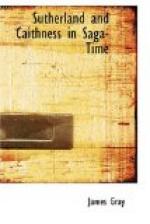[Footnote 28: We can, however, trace many parts of “Lord” Chen’s lands. For they are called the lands of “Lord” Chen in the descriptions in later charters quoted in Origines Parochiales, vol. ii, pp. 745 Reay, 749 Thurso, 760 Halkirk, 764 Latheron, 774 Wick, 787-8 Olrig, 790 Dunnet, and 814 Canisbay. His lands in all these parishes were of considerable extent. They included probably the whole modern estate of Langwell and most of the parish of Latheron, and Wick up to Keiss Bay and beyond Ackergill and Riess. In Watten they comprised Lynegar, Dunn, Bilbster, and others: in Halkirk Parish, Sibster, Leurary, Gerston, Baillecaik, Scots Calder, North Calder, and Banniskirk; in Reay Parish, Lybster, Borrowstoun, Forss, and part of Skaill and Brawlbin: in Thurso, Clairdon, Murkle, Sordale, Amster, Ormelie and the Thurso fishings; in Dunnet Parish, Rattar, Haland, Hollandmaik, Corsbach, Ham, and Swiney; while in Canisbay Parish, Brabstermyre, Duncansby, and Sleiklie belonged to Lord Chen. But neither “Lord” Chen nor Johanna ever owned Brawl, the principal seat of the Earls of Caithness; and the Earls of the Angus line had the rest, mainly in Canisbay, Bower, and the northern part of Wick parishes. Johanna did not own any of the Chen lands in the Earldom of South Caithness, which Reginald Chen III acquired after 1340, i.e. the parishes of Latheron and Wick. She probably owned the old parish of Far and Halkirk but not Latheron, though this is erroneously implied in the text.]
CHAPTER X.
[Footnote 1: Reg. Morav., pp. 88, 89, 99, 101, 333. Knighted 1215, was earl in 1226, founded the Abbey of Fearn before 1230, died about 1251.]
[Footnote 2: Robertson’s Index, p. xxi.]
[Footnote 3: Hakon Saga, 245 and 307.]
[Footnote 4: Genealogie of the Earles, p. 30, and Sutherland Book, vol. ii, p. 3 No. 4; O.P., ii, 647 note. This is not the Cross now standing. See Macfarlane, Geog. Collections, vol. ii, pp. 450 and 467, where it is called Ri-crois. The story that Dornoch took its name from the slaying of this Chief with the leg of a horse is quite unfounded, for the name Durnach appears in a charter about a hundred years earlier, and has nothing to do with a “horse’s hoof.” Its derivation and meaning are alike obscure. Chalmers, Caledonia, v, p. 192, gives to Dornock in Dumfriesshire the derivation “Dur-nochd” or the “bare” or “naked water.” Its situation is like that of Dornoch, with a wide expanse of tidal sands.]
[Footnote 5: Sutherland Book, vol. iii, p. 3, No. 4. See also Two Ancient Records of Caithness, Bannatyne Club. The bishop himself was a Canon.]
[Footnote 6: Genealogie of the Earles, pp. 6 and 31; O.P., ii, 601.]
[Footnote 7: Liber Eccles. de Scon, p. 45, No. 73. Viking Club, Sutherland and Caithness Records, No. 8, pp. 12 and 13.]




